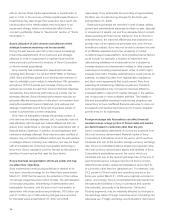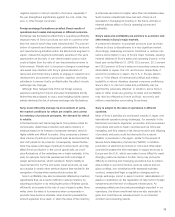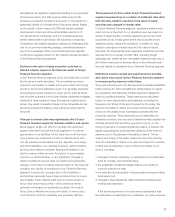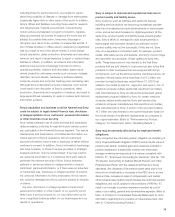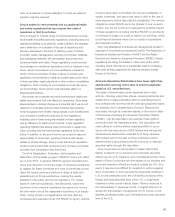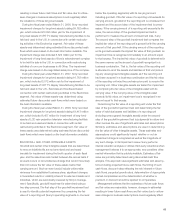Sony 2008 Annual Report Download - page 81
Download and view the complete annual report
Please find page 81 of the 2008 Sony annual report below. You can navigate through the pages in the report by either clicking on the pages listed below, or by using the keyword search tool below to find specific information within the annual report. 79
including those for semiconductors, are located in Japan,
where the possibility of disaster or damage from earthquakes
is generally higher than in other parts of the world. In addition,
Sony’s offices and facilities, including those used for research
and development, material procurement, manufacturing,
motion picture and television program production, logistics,
sales and services are located throughout the world and are
subject to possible destruction, temporary stoppage or
disruption as a result of any number of unexpected events. If
any of these facilities or offices were to experience a significant
loss as a result of any of the above events, it could disrupt
Sony’s operations, delay production, shipments and recording
revenue, and result in large expenses to repair or replace these
facilities or offices. In addition, as network and information
systems have become increasingly important to Sony’s
operating activities, network and information system shut-
downs caused by unforeseen events such as power outages,
disasters, terrorist attacks, hardware or software defects,
computer viruses and computer hacking pose increasing risks.
Although Sony is developing counter-measures, such events
could result in the disruption of Sony’s operations, delay
production, shipments and recognition of revenue, and result in
large expenditures necessary to repair or replace such network
information systems.
Sony’s reputation and business could be harmed and Sony
could be subject to legal claims if there is loss, disclosure
or misappropriation of our customers’ personal information
or other breaches of our security.
Sony makes extensive use of online services and centralized
data processing, including through third-party service provid-
ers, particularly in the Financial Services segment. The secure
maintenance and transmission of confidential information is a
critical element of Sony’s operations. Sony’s customers’
personal information may be lost or disclosed or taken without
customer’s consent. In addition, Sony’s information technology
and other systems, or those of service providers or strategic
business partners, may be compromised. If we lose custom-
ers’ personal information or if a malicious third party were to
penetrate the network security of Sony, Sony’s business
partners or service providers to misappropriate or acquire
customers’ personal information, or if there were an advertent
or inadvertent loss, disclosure or misappropriation of custom-
ers’ personal information by Sony employees, Sony’s reputa-
tion could be damaged and Sony could be subject to lawsuits
or claims.
Any loss, disclosure or misappropriation of customers’
personal information or other breach of our security would
likely have a serious impact on our reputation and could
have a significant adverse effect on our businesses and our
results of operations.
Sony is subject to financial and reputational risks due to
product quality and liability issues.
Sony products, such as software and electronic devices
including semiconductors are becoming increasingly sophisti-
cated and complicated as rapid advancements in technologies
occur, and as demand increases for digital equipment. At the
same time, product quality and liability issues present greater
risks. Sony’s efforts to manage the rapid advancements in
technologies and increased demand, as well as to control
product quality, may not be successful. If they are not, Sony
may incur expenses in connection with, for example, product
recalls, after-sales service and lawsuits, and Sony’s brand image
and reputation as a producer of high-quality products may
suffer. These issues are not only relevant to the final Sony
products that are sold directly to customers but also to the final
products of other companies that are equipped with Sony’s
components, such as the semiconductors mentioned above. An
example of these issues is the recording of a 51.2 billion yen
provision during the fiscal year ended March 31, 2007 that
related to the recalls by Dell Inc., Apple Inc. and Lenovo, Inc. of
notebook computer battery packs that use lithium-ion battery
cells manufactured by Sony as well as the subsequent global
replacement program initiated by Sony for certain notebook
computer battery packs used by Sony and several other
notebook computer manufacturers that use lithium-ion battery
cells manufactured by Sony. A portion of the provision totaling
15.7 billion yen was reversed in the current fiscal year based on
the actual results of recalls and replacements as compared to
our original estimates. (Refer to “Performance by Product
Category” for “Electronics” within “Operating Results.”)
Sony may be adversely affected by its employee benefit
obligations.
Sony recognizes the unfunded pension obligation as consisting of
the (i) Projected Benefit Obligation (“PBO”) less (ii) the fair value of
pension plan assets. Actuarial gains and losses are included in
pension expenses in a systematic manner over employees’
average remaining service periods in a manner consistent with
FAS No. 87, “Employers’ Accounting for Pensions,” FAS No. 158,
“Employers’ Accounting for Defined Benefit Pension and Other
Postretirement Plans” and the related amendments to those
standards. Any decrease of the pension asset value due to low
returns from investments or increases in the PBO due to a lower
discount rate, increases in rates of compensation and certain
other actuarial assumptions would increase the unfunded pension
obligations, and could, subject to the provisions of FAS No. 87,
result in an increase in pension expenses recorded as cost of
sales or as a selling, general and administrative expense. (Refer to
Note 14 of Notes to Consolidated Financial Statements for more
information regarding Sony’s pension and severance plans. Also
refer to “Critical Accounting Policies.”)







